Foot and Ankle Injury Doctor in New Delhi India
Are you searching for the Ankle Injury Doctor in Delhi? Do you want to book an online appointment with the Best doctors for ankle pain in Delhi NCR to discuss orthopaedic ankle-pain-related health solutions? Are you searching for the best podiatrists and orthopedic physicians who can effectively treat ankle-foot injuries and conditions in Delhi NCR? Are you looking for the Best Ankle Sprain In Delhi? Are you searching for the best Best Ankle Surgery Doctors in New Delhi? Do you want to book an online appointment with Doctors for Ankle Injury Treatment in Delhi? Do you want to Book an online appointment with a team of Doctors for Ankle Pain Treatment in Delhi? Regarding, Ankle Injury treatment, Foot Injury Treatment, and Leg Injury treatment Book an Online Appointment with Dr. Rahul Sharma MBBS, DNB - Orthopedics/Orthopedic Surgery Orthopedist, Spine And Pain Specialist - 12 Years Experience Overall (6 years as a specialist). Dr. Rahul Sharma best Leg Injury Doctor in Delhi.
Are you searching for a Leg Injury Doctor in Delhi? Do you want to know what is the best treatment at home for leg pain in Delhi? Are you looking for the best orthopedic surgeons to get a guide on how you can manage or do treatment for orthopedic conditions like - leg injuries, back pain, osteoporosis, spinal stenosis, foot injuries, sports injuries, ankle injuries, and arthritis at home? Are you searching for a team of the best leg injury doctors in Delhi? Do you want to connect with the best doctors for leg pain in Delhi, India? Are you searching for the top 10 Orthopedic Surgeons in New Delhi? Are you searching for the top 10 Leg Injury Doctors in Delhi? Regarding, Ankle Injury treatment, Foot Injury Treatment, and Leg Injury treatment Book an Online Appointment with Dr. Rahul Sharma MBBS, DNB - Orthopedics/Orthopedic Surgery Orthopedist, Spine And Pain Specialist - 12 Years Experience Overall (6 years as a specialist). Dr. Rahul Sharma best Foot Injury Doctor in Delhi.
Do you want to book an online appointment with the top 10 Foot Injury Doctors in Delhi? Are you searching for the best orthopedic hospitals for foot, leg, ankle injuries? Are you looking for a team of doctors for leg pain? Are you searching for an expert foot-ankle orthopaedic surgeon in Delhi, India? Are you searching for the Foot Disorders Best Podiatry Hospital in New Delhi, India? Do you want to know when you consult a doctor for foot pain in Delhi, India? Do you want to book an online appointment with the best foot and ankle doctor in Delhi? Are you searching for the best foot and ankle surgeon in Delhi for foot and ankle surgery in Delhi orthopedic hospital? Regarding, Ankle Injury treatment, Foot Injury Treatment, and Leg Injury treatment Book an Online Appointment with Dr. Rahul Sharma MBBS, DNB - Orthopedics/Orthopedic Surgery Orthopedist, Spine And Pain Specialist - 12 Years Experience Overall (6 years as a specialist). Dr. Rahul Sharma best Ankle Injury Doctor in Delhi.
Foot & Ankle Anatomy
The foot and ankle is a complex joint involved in movement and providing stability and balance to the body. The foot and ankle consist of 26 bones, 33 joints, and many muscles, tendons and ligaments. Are you searching for the Best doctor for ankle pain in Saket, Delhi NCR? Dr. Rahul Sharma, Ankle Injury Doctor in Delhi, is currently the Principal renowned specialist of Orthopedic Consultant and Head of the unit of Foot Ankle Surgery under the Department of Orthopedics in Life in Motion Clinic Orthopaedic hospital in India. You can also book an online appointment with Dr. Rahul Sharma. He is one of the best Orthopedic surgeon for foot and ankle surgery.
Bones of the Ankle
The ankle joint connects the leg with the foot and is composed of three bones: tibia, fibula and talus. The tibia or shin bone and fibula or calf bone are bones of the lower leg which articulate with the talus or ankle bone, enabling up and down movement of the foot.
Three bony bumps present on the ends of the tibia and fibula form parts of the ankle joint:
- The Medial malleolus, formed by the tibia, is found on the inside of the ankle;
- Posterior malleolus, also formed by the tibia, is found at the back of the ankle and the
- Lateral malleolus, formed by the fibula, is found on the outer aspect of the ankle
Bones of the Feet
The foot acts as a single functional unit but can be divided into three parts: the hindfoot, midfoot and forefoot.
The hindfoot forms the ankle and heel and is made up of the talus bone and calcaneus or heel bone. The heel bone is the largest bone in the foot.
The midfoot connects the hindfoot to the forefoot and consists of one navicular bone, one cuboid bone, and three cuneiform bones. The navicular bone is found in front of the heel bone, and the cuneiform and cuboid bones are arranged in front of the navicular bone.
These bones are connected to five metatarsal bones of the forefoot, which form the arch of the foot for shock absorption while walking or running. The forefoot is also made up of the toes or digits, formed by phalanges, three in each toe, except the big toe, which has only two phalanges. The big two has two additional tiny round sesamoid bones in the ball of the foot, which helps in upward and downward movement of the toe.
Ankle and Foot Joints
There are 33 joints in the ankle and foot. They include the
- Hinge joints in the ankle, which allow flexion (bending) and extension
- Gliding joints found in the hindfoot, which allow gliding movements
- Condyloid joints found in the forefoot and toes, which allow the flexion (bending) and extension, adduction and abduction (sideward movement).
The joints of the foot and ankle provide stability and support the weight of the body, helping you to walk or run, and to adapt to uneven ground.
The joint surface of all bones of the ankle and foot are lined by a thin, tough, flexible, and slippery surface called articular cartilage, which acts as a shock absorber and cushion to reduce friction between the bones. The cartilage is lubricated by synovial fluid, which further enables smooth movement of the bones. Do you have foot pain, ankle pain, Sports injuries, and plantar fasciitis? Immediately contact Life In Motion Clinic to consultant with the best Foot Injury Doctor in Delhi. We at LMC provide the best care and treatment for all types of foot problems and disorders. Dr. Rahul Sharma - Podiatrist - An experienced orthopaedic surgeon and the best Foot Injury Doctor in Delhi.
Soft Tissues of the Ankle and Foot
Our feet and ankle bones are held in place and supported by various soft tissues such as cartilage, ligaments, muscles, tendons and bursae.
Cartilage is the flexible, shiny, smooth tissue on the ends of bones that meet to form a joint. Cartilage provides cushioning between the bones allowing smooth movement.
Ligaments are tough rope-like tissue that connects bones to other bones and holds them in place providing stability to the joints. The Plantar fascia is the largest ligament in the foot, originating from the heel bone to the forefoot, it extends along the bottom surface of the foot and is involved in maintaining the arch of the foot. The plantar fascia ligament stretches and contracts to provide balance and strength to the foot. Lateral ligaments on the outside of the foot and medial ligaments on the inside of the foot provide stability and allow up and down movement of the foot.
The foot is made up of 20 muscles, which help in movement. The main muscles include:
- Anterior tibial muscle: allows up and down movement of the foot
- Posterior tibial muscle: supports the arch
- Peroneal tibial muscle: controls movement on the outside of the ankle
- Extensors: enable the ankle to raise the toes just before stepping forward
- Flexors: stabilize the toes against the floor
Smaller muscles are also present to help the toes lift and curl.
Tendons are soft tissues that connect muscles to bones. The largest and strongest tendon in the foot is the Achilles tendon, present at the back of the lower leg around the heel bone. Other tendons include peroneals and anterior and posterior tibialis.
Bursae
Bursae are small fluid-filled sacs that decrease friction between tendons and bone or skin. Bursae contain special cells called synovial cells that secrete a lubricating fluid.
Conditions
-
Ankle Fractures
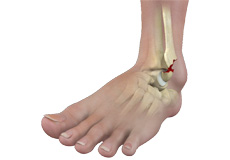 The ankle joint is composed of three bones: the tibia, fibula, and talus which are articulated together. The ends of the fibula and tibia (lower leg bones) form the inner and outer malleolus, which are the bony protrusions of the ankle joint that you can feel and see on either side of the ankle.Patient Info
The ankle joint is composed of three bones: the tibia, fibula, and talus which are articulated together. The ends of the fibula and tibia (lower leg bones) form the inner and outer malleolus, which are the bony protrusions of the ankle joint that you can feel and see on either side of the ankle.Patient InfoLisfranc (Midfoot) Injury
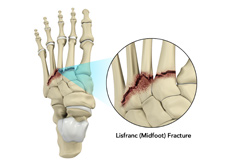 The tarsometatarsal joint refers to the region found in the middle of the foot. It is also called the Lisfranc joint. It is the junction between the tarsal bones (a group of seven articulating bones in the foot) and metatarsal bones (a group of five long bones in the foot).
The tarsometatarsal joint refers to the region found in the middle of the foot. It is also called the Lisfranc joint. It is the junction between the tarsal bones (a group of seven articulating bones in the foot) and metatarsal bones (a group of five long bones in the foot).Ankle Sprain
 A sprain is the stretching or tearing of ligaments, which connect adjacent bones and provide stability to a joint. An ankle sprain is a common injury that occurs when you suddenly fall or twist the joint or when you land your foot in an awkward position after a jump. Most commonly it occurs when you participate in sports or when you jump or run on a surface that is irregular.Patient Info
A sprain is the stretching or tearing of ligaments, which connect adjacent bones and provide stability to a joint. An ankle sprain is a common injury that occurs when you suddenly fall or twist the joint or when you land your foot in an awkward position after a jump. Most commonly it occurs when you participate in sports or when you jump or run on a surface that is irregular.Patient InfoFracture of the Calcaneus
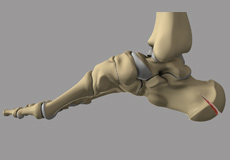 The calcaneus or heel bone is a large bone found on the rear part of the foot. The calcaneus connects with the talus and cuboid bones to form the subtalar joint of the foot. A fracture is a break in a bone from trauma or various disease conditions.
The calcaneus or heel bone is a large bone found on the rear part of the foot. The calcaneus connects with the talus and cuboid bones to form the subtalar joint of the foot. A fracture is a break in a bone from trauma or various disease conditions.Stress Fracture of the Foot
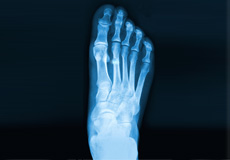 A stress fracture is a small crack in the bone which occurs from an overuse injury. It commonly develops in the weight-bearing bones of the lower leg and foot. When the muscles of the foot is overworked or stressed, they are unable to absorb the stress and transfer it onto the bone, which cracks under the pressure.
A stress fracture is a small crack in the bone which occurs from an overuse injury. It commonly develops in the weight-bearing bones of the lower leg and foot. When the muscles of the foot is overworked or stressed, they are unable to absorb the stress and transfer it onto the bone, which cracks under the pressure.Talus Fractures
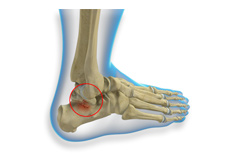 The talus is a small bone at the ankle joint that connects the heel bone and the shin bones, enabling the up and down movement of the foot. Fractures in the talus bone may occur due to a fall from great heights, motor vehicle accidents or sports injuries. Symptoms include severe ankle pain, inability to walk, swelling and tenderness.
The talus is a small bone at the ankle joint that connects the heel bone and the shin bones, enabling the up and down movement of the foot. Fractures in the talus bone may occur due to a fall from great heights, motor vehicle accidents or sports injuries. Symptoms include severe ankle pain, inability to walk, swelling and tenderness.Toe and Forefoot Fractures
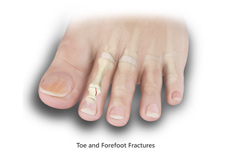 The forefoot is the front of the foot that includes the toes. Fractures occurring in this part of the foot are painful, but very often not disabling. There are 2 types of fractures namely, traumatic fracture and stress fracture. Traumatic fractures occur when there is a direct impact of your foot on a hard surface.
The forefoot is the front of the foot that includes the toes. Fractures occurring in this part of the foot are painful, but very often not disabling. There are 2 types of fractures namely, traumatic fracture and stress fracture. Traumatic fractures occur when there is a direct impact of your foot on a hard surface.Turf Toe
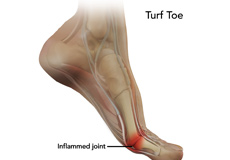 Turf toe is an injury to the ligament at the base of the big toe. It is a painful condition which usually results from jamming of the toe into the ground or excessive backward bending of the toe. As it is more common in athletes playing on artificial turf, especially those involved in field sports such as football, baseball and soccer, it is known as turf toe.
Turf toe is an injury to the ligament at the base of the big toe. It is a painful condition which usually results from jamming of the toe into the ground or excessive backward bending of the toe. As it is more common in athletes playing on artificial turf, especially those involved in field sports such as football, baseball and soccer, it is known as turf toe.Achilles Tendinitis
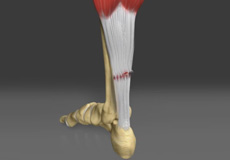 The Achilles tendon is one of the longest tendons in your body which stretches from the heel bone to your calf muscles. It appears as a band of tissue at the back of your ankle and above your heel. The Achilles tendon attaches to the heel bone over a broad area.Patient Info
The Achilles tendon is one of the longest tendons in your body which stretches from the heel bone to your calf muscles. It appears as a band of tissue at the back of your ankle and above your heel. The Achilles tendon attaches to the heel bone over a broad area.Patient InfoAdult Flatfoot
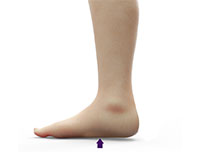 Flatfoot, also known as "fallen arches" or pes planus, is a deformity in which the arch of the foot that runs lengthwise along the sole has collapsed to the ground or not formed at all. Flatfoot is normal in the first few years of life as the arch of the foot usually develops between the age of 3 and 5 years.
Flatfoot, also known as "fallen arches" or pes planus, is a deformity in which the arch of the foot that runs lengthwise along the sole has collapsed to the ground or not formed at all. Flatfoot is normal in the first few years of life as the arch of the foot usually develops between the age of 3 and 5 years.Foot & Ankle Osteoarthritis
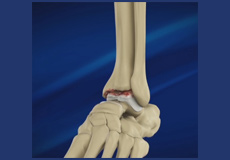 Arthritis is inflammation resulting from the degeneration of cartilage in the joint causing pain, swelling, and stiffness in the joints resulting in restricted movements. Arthritis of the foot and ankle joint can occur due to fracture, dislocation, inflammatory disease, or congenital deformity. You are at the right place to get the best Arthritis doctor in Delhi. Book an online appointment with Dr. Rahul Sharma, the best arthritis surgeon in Delhi. We at Life In Motion Clinic (LMC) provide the best care and treatment regarding Arthritis.
Arthritis is inflammation resulting from the degeneration of cartilage in the joint causing pain, swelling, and stiffness in the joints resulting in restricted movements. Arthritis of the foot and ankle joint can occur due to fracture, dislocation, inflammatory disease, or congenital deformity. You are at the right place to get the best Arthritis doctor in Delhi. Book an online appointment with Dr. Rahul Sharma, the best arthritis surgeon in Delhi. We at Life In Motion Clinic (LMC) provide the best care and treatment regarding Arthritis.Bunion
 A bunion is a bony protuberance that appears on the external surface of the big toe when it angles toward the adjacent toe. It is an extra bone and a fluid-filled sac that grows at the base of the big toe.
A bunion is a bony protuberance that appears on the external surface of the big toe when it angles toward the adjacent toe. It is an extra bone and a fluid-filled sac that grows at the base of the big toe.Claw Toe
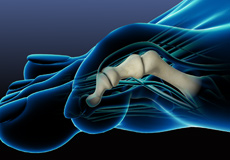 Claw toe is a deformity, where a toe bends and appears like a bird's claw. The affected toe is bent upward from the joint at the ball of the foot and downward at the joints in the middle and tip of the toe to curl under the foot. Hard thick skin called corns may develop under the ball of the foot or on the top of the affected toe, causing pain while walking.
Claw toe is a deformity, where a toe bends and appears like a bird's claw. The affected toe is bent upward from the joint at the ball of the foot and downward at the joints in the middle and tip of the toe to curl under the foot. Hard thick skin called corns may develop under the ball of the foot or on the top of the affected toe, causing pain while walking.Hammertoe
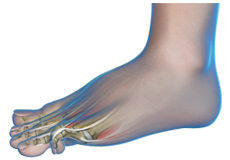 A hammertoe is a deformity of a lesser toe (second through fifth toes), where the toe gets bent upward at the toe's middle joint, resembling a hammer. The bent portion may rub against a shoe causing pain, irritation and development of corns.
A hammertoe is a deformity of a lesser toe (second through fifth toes), where the toe gets bent upward at the toe's middle joint, resembling a hammer. The bent portion may rub against a shoe causing pain, irritation and development of corns.Heel Pain
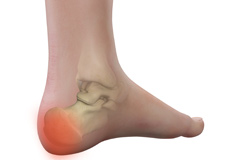 The heel is made up of the calcaneus bone and supported by a network of muscles, tendons, ligaments and soft tissues, which together support the weight of the body and stress during movement. Heel pain is a common symptom of excessive strain placed on these structures.
The heel is made up of the calcaneus bone and supported by a network of muscles, tendons, ligaments and soft tissues, which together support the weight of the body and stress during movement. Heel pain is a common symptom of excessive strain placed on these structures.Common toe Deformities
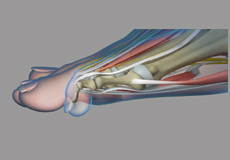 Anatomically the foot is divided into the forefoot, midfoot and hind foot. The Forefoot has 4 small toes called phalanges and 1 large toe called the hallux or big toe. Phalanges have 3 bones and 3 joints, while the big toe has 2 bones and 2 joints.
Anatomically the foot is divided into the forefoot, midfoot and hind foot. The Forefoot has 4 small toes called phalanges and 1 large toe called the hallux or big toe. Phalanges have 3 bones and 3 joints, while the big toe has 2 bones and 2 joints. Morton's Neuroma
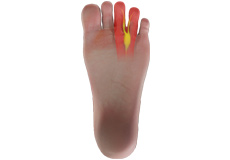 Morton's neuroma refers to a nerve injury between the toes, usually the third and fourth toes, which causes pain and thickening of the nerve tissue. Compression or chronic irritation of this interdigital nerve is the main cause of Morton's Neuroma.
Morton's neuroma refers to a nerve injury between the toes, usually the third and fourth toes, which causes pain and thickening of the nerve tissue. Compression or chronic irritation of this interdigital nerve is the main cause of Morton's Neuroma.Plantar Fasciitis
 Plantar fasciitis refers to inflammation of the plantar fascia, a thick band of tissue that lies at the bottom of the foot. It runs from the heel bone to the toe and forms the arch of your foot. Plantar fasciitis is one of the most common causes of heel pain.
Plantar fasciitis refers to inflammation of the plantar fascia, a thick band of tissue that lies at the bottom of the foot. It runs from the heel bone to the toe and forms the arch of your foot. Plantar fasciitis is one of the most common causes of heel pain.Posterior Tibial Tendon Dysfunction
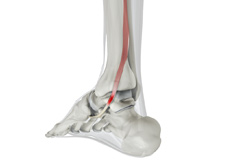 The posterior tibial tendon passes through the ankle to attach the calf muscle with the bones of the midfoot. It provides stability to the arch and supports the foot while walking. Inflammation or a tear of this tendon as a result of injury may cause dysfunction, leading to pain and the development of flatfoot.
The posterior tibial tendon passes through the ankle to attach the calf muscle with the bones of the midfoot. It provides stability to the arch and supports the foot while walking. Inflammation or a tear of this tendon as a result of injury may cause dysfunction, leading to pain and the development of flatfoot.Sesamoiditis
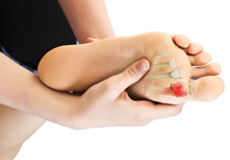 Sesamoiditis is an inflammation of the sesamoid bone and the associated tendons. It is commonly seen in ballet dancers, sprinters and basketball players. It is an overuse injury caused by an increased pressure over the sesamoid bones resulting in a chronic inflammation.
Sesamoiditis is an inflammation of the sesamoid bone and the associated tendons. It is commonly seen in ballet dancers, sprinters and basketball players. It is an overuse injury caused by an increased pressure over the sesamoid bones resulting in a chronic inflammation.Hallux Rigidus
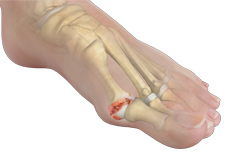 Hallux rigidus is an arthritic condition characterized by stiffness and rigidity of the big toe. Arthritis of the foot commonly occurs at the big toe base. The condition can be quite painful as the big toe has to bend with every step you take.
Hallux rigidus is an arthritic condition characterized by stiffness and rigidity of the big toe. Arthritis of the foot commonly occurs at the big toe base. The condition can be quite painful as the big toe has to bend with every step you take.Tarsal Tunnel Syndrome
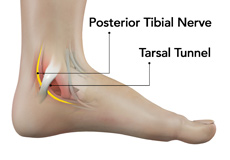 Tarsal tunnel is the gap that is formed between the underlying bones of the foot and the overlying tough fibrous tissue. Tarsal tunnel syndrome refers to a condition where the posterior tibial nerve that lies within the tarsal tunnel is compressed. The condition occurs when the tibial nerve is pinched.
Tarsal tunnel is the gap that is formed between the underlying bones of the foot and the overlying tough fibrous tissue. Tarsal tunnel syndrome refers to a condition where the posterior tibial nerve that lies within the tarsal tunnel is compressed. The condition occurs when the tibial nerve is pinched.Ankle Instability
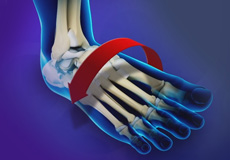 Ankle instability is a chronic condition characterized by a recurrent slipping off the outer side of the ankle. It usually results from repeated ankle sprains. It is generally noticed during movement of the ankle joint but can also occur during standing as well.
Ankle instability is a chronic condition characterized by a recurrent slipping off the outer side of the ankle. It usually results from repeated ankle sprains. It is generally noticed during movement of the ankle joint but can also occur during standing as well.Procedures
-
Bunion Surgery
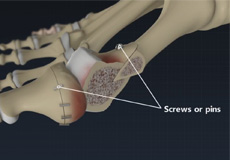 A bunion, also known as hallux valgus, is bony prominence at the base of the big toe, which often results in pain, redness and rubbing in footwear. The 1st metatarsal bone abnormally angles outward towards the other foot from its joint in the midfoot. Do you have the following questions regarding Bunion Surgery?
Does bunion surgery is painful? Can a patient walk after bunion surgery? How long it takes to heal after bunion surgery? Have any queries regarding orthopaedic surgery? Are you facing Orthopedic health problems? Consultant online with Life In Motion Clinic best orthopaedic surgeon Dr. Rahul Sharma.
A bunion, also known as hallux valgus, is bony prominence at the base of the big toe, which often results in pain, redness and rubbing in footwear. The 1st metatarsal bone abnormally angles outward towards the other foot from its joint in the midfoot. Do you have the following questions regarding Bunion Surgery?
Does bunion surgery is painful? Can a patient walk after bunion surgery? How long it takes to heal after bunion surgery? Have any queries regarding orthopaedic surgery? Are you facing Orthopedic health problems? Consultant online with Life In Motion Clinic best orthopaedic surgeon Dr. Rahul Sharma. -
Achilles Tendon Repair
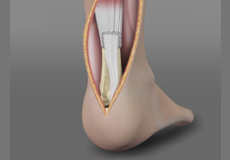 Achilles tendon is a strong fibrous cord present behind the ankle that connects the calf muscles to the heel bone. It is used when you walk, run and jump. The Achilles tendon ruptures most often in athletes participating in sports that involve running, pivoting and jumping.
Achilles tendon is a strong fibrous cord present behind the ankle that connects the calf muscles to the heel bone. It is used when you walk, run and jump. The Achilles tendon ruptures most often in athletes participating in sports that involve running, pivoting and jumping. -
Cheilectomy
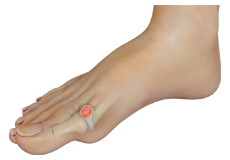 Cheilectomy is a procedure to remove excessive bone from the first metatarsophalangeal joint (MTPJ). The MPT joints are the junctions between the metatarsal bones (long bones in the foot) and the proximal bones (bone in toes).
Cheilectomy is a procedure to remove excessive bone from the first metatarsophalangeal joint (MTPJ). The MPT joints are the junctions between the metatarsal bones (long bones in the foot) and the proximal bones (bone in toes). -
Ankle Ligament Reconstruction
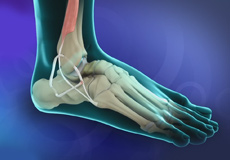 An ankle sprain is a common injury and occurs when you fall or suddenly twist the ankle joint or when you land your foot in an awkward position after a jump. It most commonly occurs when you participate in sports or when you jump or run on a surface that is irregular.
An ankle sprain is a common injury and occurs when you fall or suddenly twist the ankle joint or when you land your foot in an awkward position after a jump. It most commonly occurs when you participate in sports or when you jump or run on a surface that is irregular. -
Ankle Arthroscopy
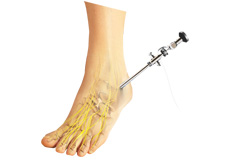 Ankle arthroscopy is a minimally invasive surgical procedure in which an arthroscope, a small, soft, flexible tube with a light and video camera at the end, is inserted into the ankle joint to evaluate and treat a variety of conditions.
Ankle arthroscopy is a minimally invasive surgical procedure in which an arthroscope, a small, soft, flexible tube with a light and video camera at the end, is inserted into the ankle joint to evaluate and treat a variety of conditions. -
Ankle Fusion
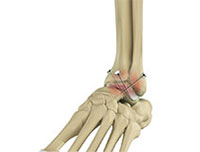 Ankle fusion or arthrodesis is the surgical union of bones that forming the ankle joint. The ankle joint is formed by the tibia, talus, and the fibula bones. The goal of ankle arthrodesis is to relieve pain in the affected joint. This is achieved by surgically eliminating the joint.
Ankle fusion or arthrodesis is the surgical union of bones that forming the ankle joint. The ankle joint is formed by the tibia, talus, and the fibula bones. The goal of ankle arthrodesis is to relieve pain in the affected joint. This is achieved by surgically eliminating the joint.
